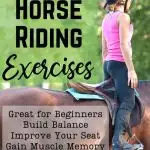Horseback riding, or equestrianism, involves the skill of riding, driving, or vaulting with horses. This broad description includes using horses for practical working purposes, transportation, recreational activities, artistic or cultural exercises, and competitive sports such as dressage and eventing. People have improved horse riding skills for war, transport, and horse shows over time. (Source)
New riders must learn to communicate well with their horse. Use leg aids, seat, and hands for control and guidance. Regular practice of basic exercises enhances balance and coordination, crucial for any equestrian discipline. Remember, consistent practice is key.
These 19 beginner horse riding exercises will get you started with some fundamentals so you can start working on today to get the most out of your riding experience. For more inspiration, check out the books I reference at the bottom of the post including my favorite: 101 Arena Exercises for Horse & Rider
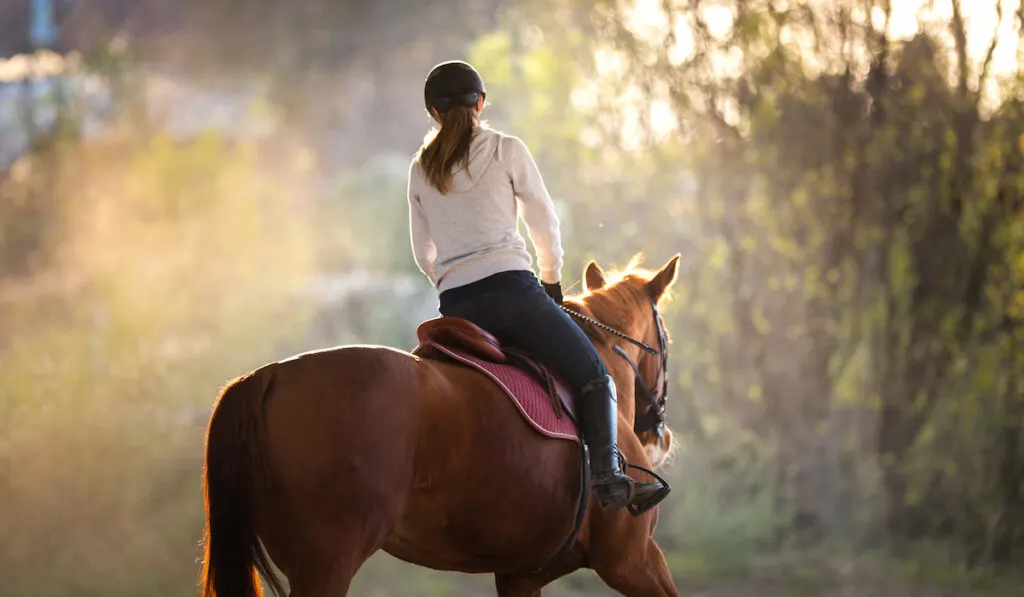
If you’re looking for ways to shake up your riding routine, here are 19 exercises you can try whether you are just starting, teaching new riders, or already experienced.
Table of Contents
Key Takeaways : Riding Quick Start Guide
- Arm Exercises for Balance: Key for better coordination and riding posture. These exercises include arm circles, hand placements, and body twists.
- No Stirrups Exercises: Helps build balance and proper leg position. It includes activities like taking feet in and out of stirrups and riding without stirrups.
- Games for Engagement: Incorporates fun activities like ‘Around-The-World’ and ‘Red Light, Green Light’ to make learning enjoyable and engaging for beginners.
Horse Riding for Beginners – Basic Guide
Starting your journey in horseback riding can be exciting and challenging. Here’s a basic guide for beginners:
- Learn Leg Position: Mastering the correct leg position is crucial. It helps in controlling the horse effectively.
- Practice Leg Aids and Rein Control: Use leg aids and reins to direct your horse. Pay attention to how they respond to your commands.
- Work on Balance Through Leg Exercises: Regular leg exercises are ideal for improving balance and stability on the horse.
- Start with Easy Patterns: They help build coordination and confidence.
- Trail Riding: If possible, try trail riding; it’s a great way to experience different terrains and scenarios.
- Seek Professional Advice: If you’re not sure, always ask a professional. They can prevent bad habits and provide tailored exercises needed for improvement.
In the following sections, we’ll dive into 19 detailed lessons to help you master each of these essential skills for a fulfilling horse riding journey.
Arm Exercises for Balance
Beginners should try these exercises on a lunge line or with a lead rope. Advanced riders can also try them at different gaits, or perform them in a sequence.
These exercises improve coordination, balance, and help keep the chest open.
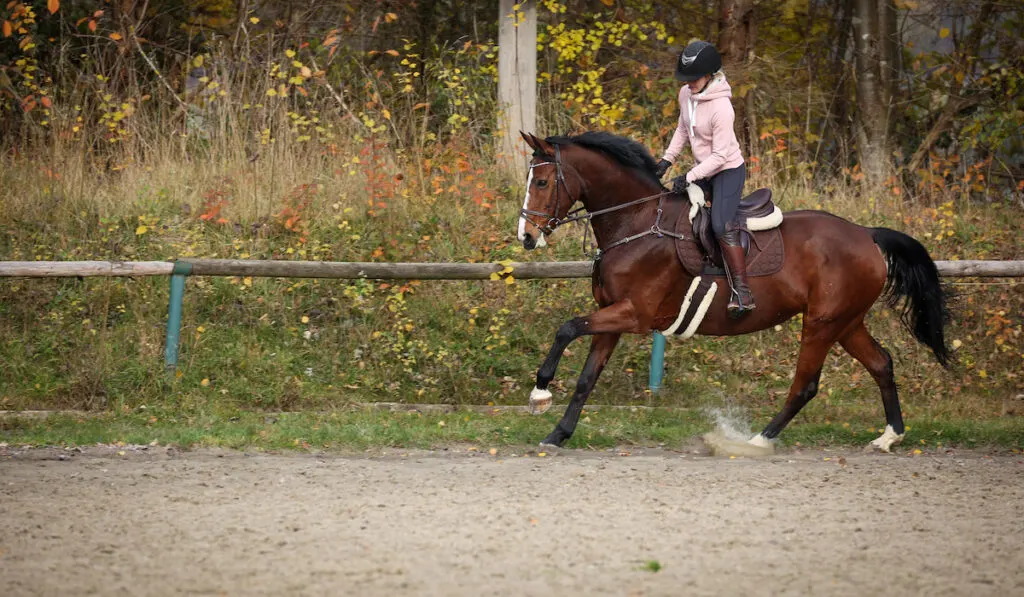
Arm Circles
Stretch one arm to the side and make large, slow backward circles. Switch arms and do it again. You can try with both arms if someone else controls the horse.
One Hand Behind the Back
Stretch your arm out, then put it behind your back with the palm out. Switch arms and repeat.
Arm Extensions
One by one, stretch your arms out, then forward, up, and back. Keep your eyes up and forward.
Hand on Your Head
Extend the arm out to the side, and then place it on your helmet. This movement can be added to a sequence to improve coordination and focus.
Body Twists
When your horse is on a lunge line, extend your arms to the sides like an airplane. Twist your upper body ninety degrees so that your chest becomes parallel with your horse.
Be careful with your back, and when ready, try it at a trot or canter. It’ll really test your balance!
Exercises with No Stirrups
This is a great exercise for practicing the correct position. However, this can be challenging for beginners, so work your way up from a walk to faster gaits like trot or canter.
Practice Taking Your Feet in and out of the Stirrups
Take one foot out of the stirrup, ride a bit, then put it back. Try not to look down or use your hand.
Keep practicing until you’re comfortable with the stirrups. This is an important skill for any rider, as we all lose a stirrup now and then!
Ride with No Stirrups
Start with one foot at a time, so you can maintain proper balance and feel where your leg is supposed to be. Even with your foot out of the stirrup, your leg should stay in the proper position (knee bent, your ankle in a straight line under your hip, toes up).
Try this exercise at various gaits, and work your way up to riding with no stirrups at all – or bareback!
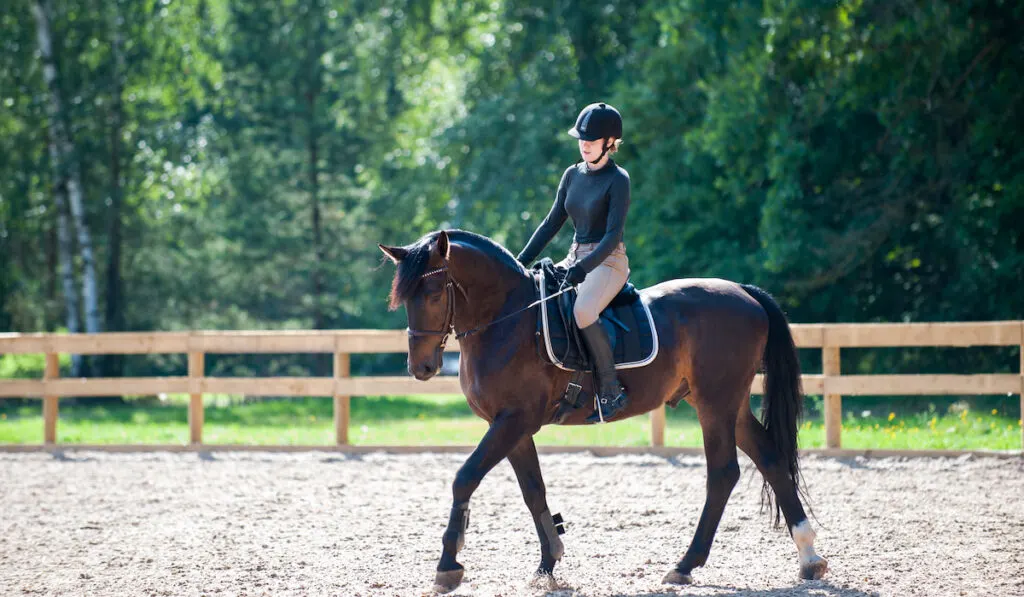
Leg Lifts
Take your foot out of the stirrup and slowly lift your leg a few inches. Slowly move it up and down, lifting from the hip.
The stretches and strengthens your hips, and helps you sit better on your “pockets.” You can also try doing circular movements with your legs away from the saddle.
Be careful not to inadvertently kick your horse in the process, but a seasoned school pony would be a perfect partner for these sorts of exercises.
Toe Circles
With one or both feet out of the stirrups, lift your toes and roll them in small circles. This will help improve your balance, stretch your ankles, and get you thinking about your toe position.
Lunge with No Stirrups and No Hands
As your balance and strength improve, you can combine the stirrup exercises with the arm exercises while your horse is on a lunge line. This can be quite the workout for a beginner, so start slowly to build your strength.
Games
Exercise is fun! If you’re a trainer and you want to add some whimsy to your riding routine in a beginner group lesson, try some games to shake things up.
Around-The-World
This exercise generally requires a helper to hold, lead, or lunge the horse. Safety is always the most important factor when attempting any riding exercises.
Begin by sitting astride your horse in a normal position. Then, swing your leg over your horse’s neck so both feet are on the same side. Swing your other leg over your horse’s rear, so now you’re sitting backward in the saddle. Continue until you reach a normal forward riding position. Try it in either direction – but be careful not to whack your horse in the head or rump!
Red Light, Green Light
This classic children’s game is perfect for practicing gait transitions and listening skills. Call out directions: “red light” means “stop” (or downward gait transition). “Green light” means “move forward”.
The last person to stop or transition is eliminated. Continue until one rider remains victorious. Just make sure your beginners aren’t yanking on their horses’ mouths!
Simon Says or Follow the Leader
This game is great for practicing arm circles, stirrup work, and listening skills. Appoint someone to call commands – you can try gait changes, transitions, arm circles, no-stirrups, etc. Eliminate riders as you catch them not heeding “Simon’s” directions.
You can also play a variation of this game as “follow the leader” instead, where riders must follow and match another rider’s movements as they make their way around the ring.
Ride a Buck
Place a dollar bill (or slip of paper) underneath the riders’ legs. Continue the lesson with regular drills or exercises.
The last rider to hold on to their dollar gets to keep it! You can place the paper underneath different points of contact for your riders, depending on their abilities and strengths.
Riding Exercises
Try these different exercises at various gaits, depending on your abilities.
Two-Point Over Poles
Even if you don’t plan on becoming an Olympic show-jumper, riding your horse over a ground pole in a two-point position is a fun way to improve balance and work on your concentration. And if you do plan on jumping in the future, it’s a great way to get an introduction to the foundations of jumping.
Cone Bending
Set up a line of cones down one side of the arena. Practice weaving your horse through these cones. This can help you work on steering, and it’s a good way to loosen up your horse and get him paying attention as well.
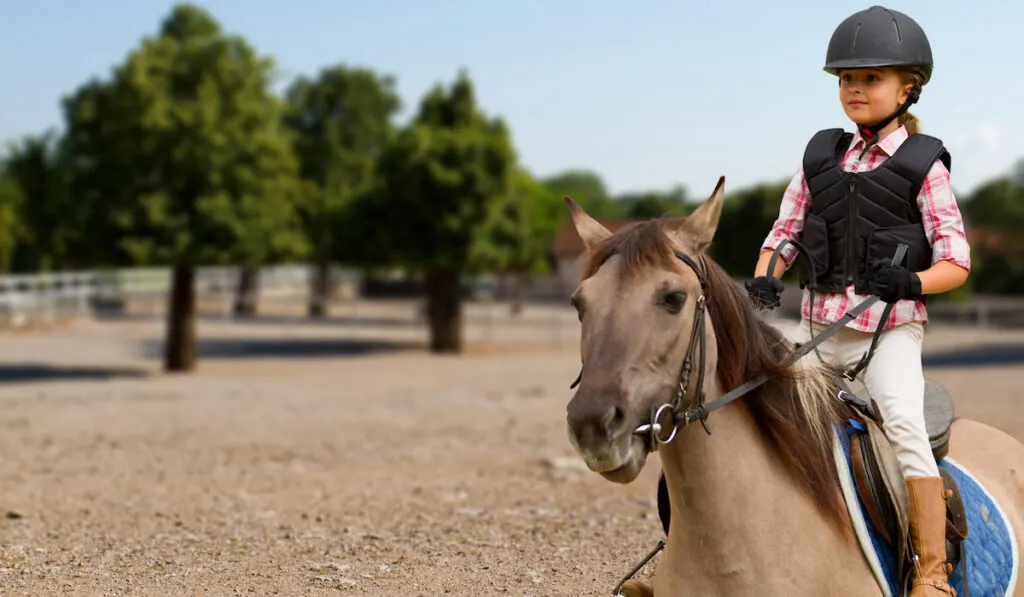
Diagonal Changes
Once you’ve mastered posting, shake up your trotting exercises by practicing some diagonal changes. You can try the following exercises:
- Post for three strides, sit for two strides. Repeat as necessary.
- Try changing your diagonal every two strides as you make your way around the arena.
- Consider performing a posting trot down the length of the arena, and then try a sitting trot in the corners. Work on controlling the speed of your horse with your body and legs, rather than your hands. A posting trot is often faster than a sitting trot depending on your discipline and horse, so play with variations in speed during this exercise.
Riding Exercises with Physical Reminders
Sometimes, beginners can get into bad habits that can be hard to break. Sometimes, adding a simple odd accessory can help re-train your muscles properly.
Straightening the Wrists
Are your wrists floppy, or always bent? Try adding a wide tongue depressor or popsicle stick to the inside of your wrist, and securing it with tape. As you ride, the wooden sticks will help keep your wrists straight. You can also use wrist braces or wrist guards. (source)
Taping the Reins
If you have trouble remembering how long or short your reins are supposed to be, you can mark them with colored tape. Riding programs with a lot of beginners often invest in multicolored reins to remind their students where their hands should be. (source)
While engaging in horseback riding, participants experience a plethora of health benefits. This link offer insights into these advantages, ranging from the muscle development it fosters to the emotional well-being it promotes. Here is an available resource to assist you in planning your horse riding activities and exercise regimen.
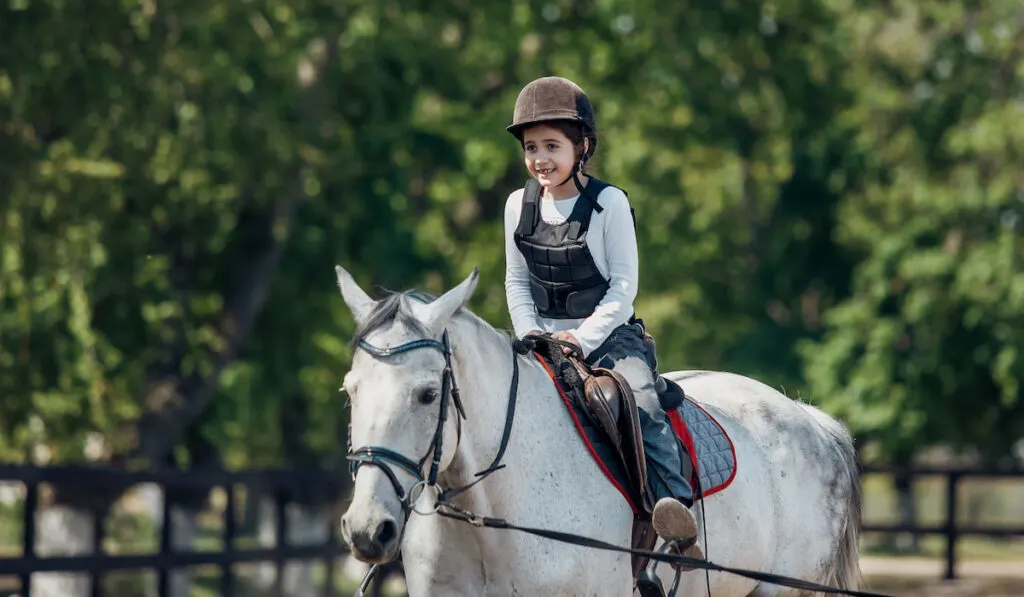
Arena Exercises for Horseback Riding
Practicing in an arena offers a controlled environment for developing riding skills. Here are a few key exercises:
- Circles and Bends: Riding in circles improves your horse’s flexibility and your ability to steer accurately.
- Serpentines: This exercise enhances control over direction and pace while teaching smooth transitions.
- Transitions: Work on changing gaits smoothly, like from walk to trot, and trot to canter, to improve your horse’s responsiveness.
- Figure-Eights: This helps in balancing both sides of the horse and the rider, promoting symmetry in movements.
- Obstacle Courses: Setting up small jumps or poles can teach precision and timing.
Regular arena exercises not only boost your riding technique but also strengthen the bond and understanding between you and your horse.
Now when we covered the basics, let’s learn more! Discover the Elegance of Dressage Riding – Click Here to Learn More!
Frequently Asked Questions (FAQ):
What Are the Best Exercises for a True Beginner?
The best exercises for a true beginner in horseback riding focus on foundational skills such as balance, control, and communication with the horse. Key exercises include practicing riding without stirrups to improve balance, and doing basic arm exercises to enhance coordination.
How Often Should I Practice?
For beginners, it’s generally recommended to practice horseback riding exercises 2 to 3 times a week. This frequency allows for consistent progress while giving enough time for both the rider and the horse to rest and process the new skills.
What Is the Best Equipment for Beginner Horseback Riders?
The best equipment for beginners includes a well-fitting helmet, comfortable riding boots with a small heel, gloves, and appropriate riding pants. A safety vest is also recommended for extra protection.
Here are our suggestions for choosing the best helmet for kids.
What if I Fall? Is There an Excecise or Falling Technique I Could Practice?
Yes, learning proper falling techniques can reduce injury risk. Key points include tucking your chin, rolling away from the horse, and trying to relax your body to absorb the impact.
Helpful Resources
When it comes to horses, there are many tools and techniques that riders can use to improve their balance as well as develop a relationship with their horse. If you are looking for more ideas, these are some of my favorite books targeted specifically for beginner riders.
- 101 Arena Exercises for Horse & Rider
- First Horse: The Complete Guide for the First-Time Horse Owner
- 40 Fundamentals of English Riding: Essential Lessons in Riding Right
- Judy Richter's Riding for Kids
Have fun, but be safe!
Regardless of what discipline you choose, these horse riding exercises can be valuable for teaching beginner students or used as part of your own exercise program to improve in areas you may be lacking.
As always, remember to consult a professional if you’re unsure – and always ride safely for the best of your abilities!
Related Posts
- Basic Groundwork Exercises w/FREE Printable Training Log
- 26 Fun Groundwork Exercises to Try with Your Horse
- Choosing the Right Size Horse for Your Height and Weight
- 10 Easy Horse Obstacles Under $20
- Can You Ride a Horse on the Road + Legal Guide & Safety Tips

